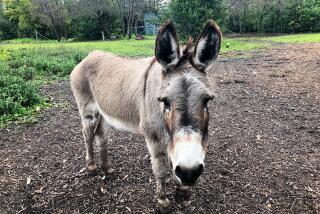Pigeons Fall for Corny Idea to Trim Flock in Balboa Park
- Share via
What do you do if the park is overpopulated with pigeons? Put the pigeons on The Pill.
Under a program started in August, the City of San Diego hopes to reduce by half the number of pigeons in Balboa Park by feeding the birds whole kernel corn laced with the birth control agent Ornitrol.
The city commissioned Lloyd Pest Control to come up with the idea when it was found that the number of pigeons living in the park was so large that their droppings were becoming a potential health hazard and damaging the buildings there.
“The number of pigeons there in the park is out of hand and a mess,” said Herb Field, an urban entomologist in charge of the birth control project. “We climbed up the tower of the Museum of Man and it was practically impossible to breathe. There were rotting bird bodies, and it was six to eight inches thick with droppings. I’ve never seen anything like it.”
“The droppings from these birds is acidic, and will eventually become gaseous if it builds up for a long period of time,” Field said. “We aren’t looking for zero population, we didn’t want to just go out and eliminate these birds. I mean, we didn’t want to ruffle anyone’s feathers, so to speak.”
Balboa Park Manager Marcia McLatchy said the museum buildings in Balboa Park had suffered damage because of the large pigeon population.
“The damage to the buildings is very bad and in some cases irreparable,” McLatchy said. “The droppings eat through the plaster, and does unbelievable things when there’s a large buildup of the stuff. It is so unsightly and creates an odor we want to eliminate.”
Field said it will be at least two years before there is any significant decrease in the number of pigeons, as the older birds die out and the birth control reduces the number of births.
“Sure, there’ll be other flocks from other areas coming into the park, but to a large extent pigeons will remain in the area they were born,” Field said.
Under the birth control plan, pigeons were fed non-laced corn for a couple of weeks to make sure no other types of birds living in the park would eat it, Field said. Then, for about 10 days, the Ornitrol-laced corn was fed to the pigeons. The process has to be repeated only every six months because one feeding cycle is sufficient to disrupt the female pigeon’s cycle for that period of time.
There is no danger to other animals or humans, Field said, because the dosage is not strong enough and the corn is placed on rooftops and eaves out of the reach of people.
“We are concerned about the pigeon population in the park,” McLatchy said. “I didn’t want to harm the birds or any of the babies that might be produced, and this was a sure-fire safe way to control future births.”
The cost to the city is about $8,000 every six months and city officials hope to reduce the number of pigeons living in the park from 5,000 to 2,500 in the next two years.
More to Read
Sign up for Essential California
The most important California stories and recommendations in your inbox every morning.
You may occasionally receive promotional content from the Los Angeles Times.













